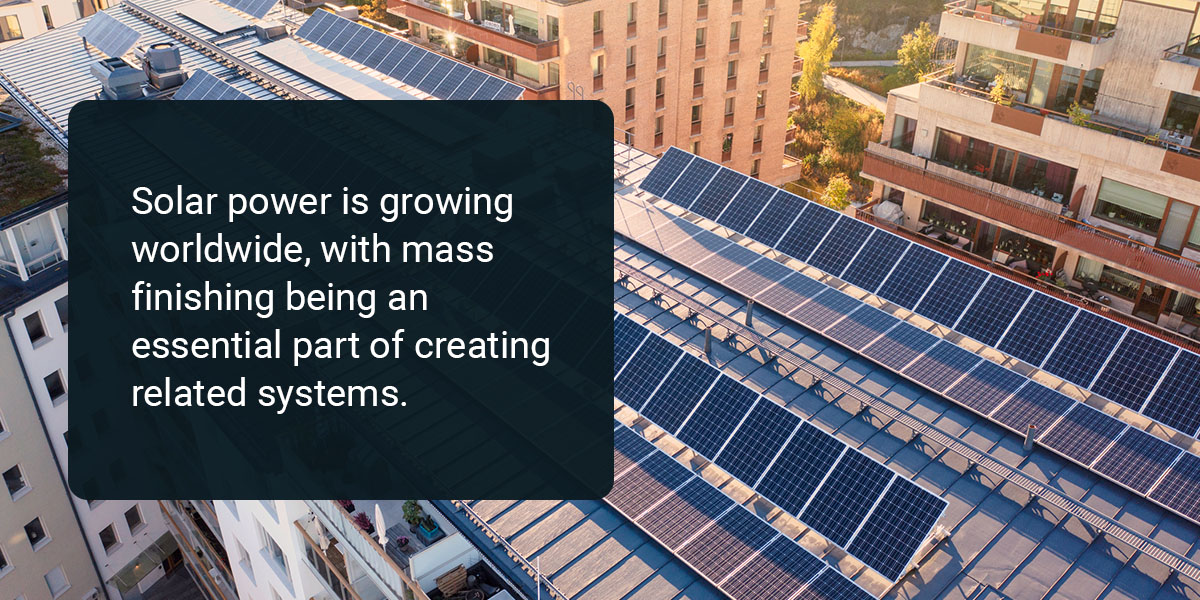Mass finishing in manufacturing is an empirical and invaluable part of the production process. Having the right equipment to finish large-scale products helps align your business goals with output volume and profits, impacting your bottom line positively.
In the solar industry specifically, mass finishing is important in ensuring solar-powered products are smoothed and finished perfectly to allow them to perform their functions optimally. Below, we look at what the mass finishing process entails, examples and benefits of mass finishing for solar, and why you need it.
What Is the Mass Finishing Process?
When finishing products on a mass scale, the goal is to save time while making sure the quality is not compromised. This is achieved by using media to clean and finish components placed in a specialized chamber that keeps them apart. Doing this is vital to minimize damage to each individual component.
The abrasive materials are comprised of minuscule, granular pieces that may include any of the following:
- Nutshells
- Ceramic
- Steel
- Plastic
- Rock
- Wood
The high-velocity spinning action inside the chamber helps eliminate burrs and smooths the surface area. Adding liquid or powder compounds further performs the role of cleaning.
There are a few essential steps in the mass-finishing process itself, highlighted below:
- Cleaning: Components must be cleaned of any residue or dust that could hinder the process further on. The surface is inspected, and any particles are removed with the help of compounds.
- Deburring: The media removes ridges, lines or excess steel edges on the component that impedes the smoothness of the surface.
- Inhibiting: Components are protected from corrosion by applying an inhibitor to the surface.
- Polishing: Polishing components with certain abrasive materials like nutshells ensures they are clean, deburred, inhibited and ultimately shiny and appealing to the eye.
- Drying: Drying the components eliminates the risk of oxidization, depending on the type of compounds used during finishing.
Finishing helps refine each individual component collectively, ensuring consistency in the end result of the mass production process.
Mass Finishing Examples for Solar
Solar resources offer a definitive method of contributing to a more environmentally friendly planet. The following examples explore why mass finishing adds value to the solar industry.

Solar Panels
Solar panels are manufactured for private, commercial and industrial use and offer a cost-effective way of generating a renewable source of energy. How much energy a solar panel generates depends on the intensity of the light the panels absorb.
Solar panel production includes the following processes:
- Silicon and other chemical constituents are combined into wafers and cut during the iso-texturization process. This is where sawing damage is analyzed and removed.
- These wafers form the cells used to conduct the sun’s light. They are protected by plastic or glass.
- The cells are arranged neatly on a base made of conductive material to ensure they are uniform and connected.
- Here, key equipment like laser cutters and deburring machines are used to smooth the edges of the panels that are covered in the recognizable blue anti-reflection coating.
- A polymer frame then holds the cells and base while acting as an insulator.
- The entire component is housed in thick glass to preserve it against the elements when exposed.
Solar power is growing worldwide, with mass finishing being an essential part of creating related systems.
Contact Us For Your Mass Finishing Solar Needs
Concentrating Solar-Thermal Power (CSP) Systems
With CSP, mirrors are used to direct sunlight onto a tube-like receiver that holds high-temperature liquid. Heat or thermal energy is created by this fluid and converted into electricity using a steam engine that can be stored or used in industrial processes. This differs from solar or photovoltaic cells that use light from the sun to generate energy.
One advantage of using CSP systems is that they can supply any amount of kilowatt applications, whether it is 100 kilowatts for small-scale utilities or households, or 1,000 megawatts on grids that power communities.
There are numerous systems used to perform this task. Here, the main three are summarized:
1. Trough Systems
These concave conducting systems are embedded with mirrors that direct the heat of the sun to a receiver pipe that contains oil. This heated oil then produces steam by using a heat exchanger or generator, which in turn creates electricity in a turbine. They are placed in rows on a north-to-south pivot to ensure full coverage at all times and work on a hybrid system, using nonrenewable means to generate electricity when there is a limited sunlight supply.
2. Dish Systems
The dish or solar concentrator houses a multitude of mirrors arranged parabolically. They steer the sun’s light to the receiver in the center, where it is redirected to an engine that eventually converts the light into heat. This heat leads to mechanical power that generates electricity through an alternator, similar to a car’s engine.
This system generates fewer kilowatts than its counterparts but is still as effective.
3. Central Receiver System (CRS)
In a CRS, also known as a power tower, the receiver located on top of the tower reflects the sun’s rays onto a heliostatic field of mirrors. The liquid in the receiver turns into molten salt, traveling down the tower to a steam engine at the base. Here, it can be stored for lengthy periods before being converted to electricity.
Why You Need Mass Finishing for Solar
Based on the technology and different parts used in solar panels and CSP systems, using mass-finishing equipment for any of them would ensure the mirrors, receivers and other components are flawless in executing their intended functions. Solar mirrors would have no visible warping, shaping or bending due to high-precision finishing.
Considering the benefits and long-term impact of using mass finishing equipment for products in the solar industry, it is clear that it will serve a far greater purpose than what it is intended for. More benefits include improved durability of the components, enhanced chemical resistance, advanced surface conductivity and unparalleled corrosion resistance.
Contact Us Today
Advanced Deburring & Finishing offers the equipment and supplies you need to complete superior surface finishing and cleaning. With years of experience in the industry, our team can offer the expertise and support you need to help you make an informed decision for your operations.
Explore our surface finishing and refinement products to discover components that suit your needs. Contact us with any questions at (800) 553-7060 or by filling out an online form.
Read More